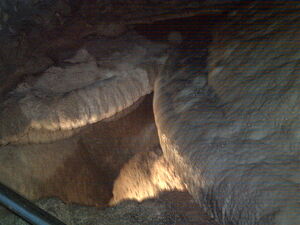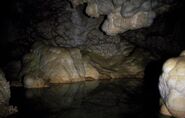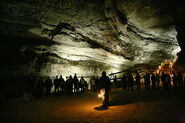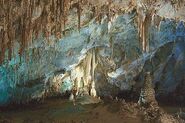

Chronology[]
1400 -- Mescalero Apaches come to the Guadalupe Mountains area.
1536 -- Cabeza de Vaca is the first of the Spanish explorers to cross southeastern New Mexico.
1583 -- Antonio de Espejo leaves Acoma and travels south along the Pecos River into Texas. He calls the river Rio Salado.
1610 -- Spanish Colonists establish La Villa Real de Santa Fe de San Francisco, now known as Santa Fe.
1724 -- Pedro de Rivera inspects the province of New Spain. His engineer, Francisco Alvarez y Barriero is one of the first to map the Guadalupe Mountains.
1745 -- Padre Juan Miguel Menchero maps the area of present day Carlsbad. He indicates herds of cattle along the Pecos River.
1800-1859[]
1849 -- Captain Randolph B. Marcy explores the Guadalupe Mountains area. Numerous expeditions cross this area recently acquired by the United States.
1850 -- September 9, New Mexico becomes a Territory.
1854 -- Captain John Pope of the Army Topographical Corps crosses the Guadalupe Mountains surveying possible routes for the railroad.
1855 -- The U. S. Army begins scouting the Guadalupes for Mescalero Apache raiders. Major John S. Simonson of Fort Davis and Captain James Longstreet of Fort Bliss mount patrols of infantry and mounted riflemen.
1858 -- The route of the Butterfield Overland Mail runs through the Guadalupe Mountains. A stage station is established at Pine Springs.
1860-1879[]
1866 -- Charles Goodnight and Oliver Loving begin driving cattle north along the Pecos River on the route that becomes known as the Goodnight-Loving Trail. Loving is severely wounded in an Indian fight at Loving Bend on the Pecos River (later depicted in the novel Lonesome Dove).
1867 -- John Simpson Chisum drives his first herd of cattle along the trail from Texas into New Mexico. He begins a ranch that soon extends from near Fort Sumner to the Black River.
1869 -- Lieutenant Howard B. Cushing mounts a punitive expedition from Fort Stanton against Mescalero raiders in the Guadalupes. His troopers destroy three major Apache encampments in less than two months.(within the future site of Guadalupe Mountains National Park)
1870 -- Seven Rivers (originally called Dogtown because of the prairie dog colonies there) is settled by the Herskill Jones family of Virginia. Situated where seven arroyos lead into the Pecos River, it became an important trading post on the cattle trail from Texas. Outlaw Billy the Kid frequently visited Seven Rivers.
1875 -- John Chisum moves his cattle north from Black River. He continues to graze as far south as Seven Rivers.
1878 -- Dogtown is renamed Seven Rivers for the seven arroyos flowing into the Pecos at that point. The Tenth Cavalry (nicknamed the "Buffalo Soldiers") establishes a permanent camp at the old Pine Springs stage station in the Guadalupe Mountains. In October, Colonel Benjamin Grierson visits the camp and explores the Black River canyon.
1880-1889[]
1880 -- The Tenth Cavalry under Colonel Grierson crosses the Guadalupes and camps near the mouth of Black River on their way to the Fort Stanton reservation. There are several skirmishes with Apache parties supporting Victorio. Dan Lucas begins ranching along the Black River on the property that is now Washington Ranch.
1881 -- Henry Harrison arrives from Indiana and homesteads at Rattlesnake Springs. Cavalry patrols use his farm as a point of supply during the 1880's. Colonel Nelson Miles and the Ninth Cavalry use Rattlesnake Springs as a rendezvous and supply camp in 1881-1883.
1882 -- William C. Sublett finds gold nuggets in the Guadalupe Mountains eight to twelve miles from Pine Springs. Speculation is that the nuggets came either from a lost mine or from a cache of gold stolen from the Butterfield stage.
1882 -- July 11, Jim White, future explorer of Carlsbad Cavern, is born in Mason County, Texas.
1884 -- Charles B. and John Eddy form a livestock company with Amos Bissell to operate in southeastern New Mexico. One of their first ventures is the Halagueno Ranch which covers the area from Seven Rivers to La Huerta, NM. (Halagueno is Spanish for promising and attractive)
1885 -- The Valley Land Company owned by Dan Harroun holds the first water rights on the Pecos River.
1886 -- This was known as the year of the "big die." Drought causes the loss of about thirty-five percent of area cattle.
1887 -- Charles B. Eddy builds the Halagueno diversion ditch on the Pecos River three miles above the later site of Avalon Dam and incorporates the venture as the Pecos Valley Land and Ditch Company.
1888 -- Former sheriff Pat Garrett and promoter Charles Greene join with Charles Eddy to create a system of canals and flumes for diversion of water to their properties. Greene secures potential investors from the east including Robert W. Tansill, manufacturer of the Punch five cent cigar. Plans for a new town on the Pecos River are laid out by Eddy and his partners. September 15, The town of Eddy is christened in champagne on the south bank of the Pecos River.
1889 -- February 25, Eddy County is created. The first county seat is at Seven Rivers. James John Hagerman, miner and railroad builder, becomes a partner in the Pecos Irrigation Company. October 6, The first school in Eddy opens on South Main with thirty-five pupils. Future cavern guano miner John B. Forehand establishes a ranch on the Black River.
1890-1899[]
1890 -- March, The Witt brothers complete construction of a wooden flume near Eddy for irrigation. The county seat changes from Seven Rivers to Eddy by a vote of 331 to 83. The bridge over the Pecos River at Greene Street in Eddy is completed. Avalon Dam and many of the canals leading from it are completed, financed by James J. Hagerman.
1891 -- January 10, The first railroad train arrives in Eddy on the newly completed line from Pecos, Texas. Kirkwell, a station on the Pecos Valley Railway is settled by Swiss farmers. Its name is changed to Malaga after a type of grape grown there.
1892 -- In April and May the first businesses open in Phoenix. Located just south of Eddy, it consists of saloons, gambling halls and houses of prostitution. One visitor to Phoenix's establishments was John Wesley Hardin. In 1895, the saloons and gambling centers of the Phoenix move on with the end of prohibition in Eddy. Jim White's family settles at Lone Tree New Mexico Territory, a ranching community eight miles east of Eddy.
1893 -- the town of Eddy is incorporated.
1893 -- Heavy rains in July and August cause floods that wash away Avalon Dam, the wooden flume, and the Greene Street bridge. A school building is completed in Eddy at the present site of Edison School.
1894 -- By October, the railroad is complete from Eddy to Roswell, NM.
1895 -- Jim White's family moves to join him in New Mexico.
1898 -- The first hospital and library are started in Eddy. Rock in main corridor inscribed "J White" and "1898" suggests that White probably entered the cavern for the first time in 1898.
1899 -- May 23, Robert W. Tansill proposes changing the name of Eddy to Carlsbad after the mineral water spa in Czechoslovakia. This is approved by general city election.
1900-1919[]
1903 -- A cement flume, replacing the wooden one that washed away, is completed at Carlsbad. June 16, Abijah Long establishes placer mining claim, 20 acres around natural entrance to cavern.
1903 -1923 -- Main period of guano mining at the cavern.
1906 -- June 8, The Antiquities Act gives the President power to proclaim national monuments and also prohibits excavation or appropriation of antiquities on federal lands.
1912 -- January 1, Jim White marries Fannie Hill.
1912 -- January 6, New Mexico becomes a state, 62 years after becoming a territory.
1915 – 1918: Ray V. Davis takes the first photographs from inside the caverns.
1916 -- August 25, Congress establishes the National Park Service.
1918 -- First photographs in the cavern's Scenic Rooms and Big Room taken by Ray V. Davis. His photographs stimulates interest in the cavern. Davis' photos appear in the New York Times in 1923.
1918 -- New Mexico Governor W. E. Lindsay incorporated the town of Carlsbad.
1920-1929[]
1923 -- Ray V. Davis caverns photographs are first published in the New York Times.
1923 -- (April 6 – May 8): Jim White guides Robert Holley of the General Land Office and Ray V. Davis (photographer) to survey and map the caverns. Holley recommends the establishment of a National Monument. August 6, Major Richard Burgess, prominent El Paso lawyer, begins campaign to make the cavern a national monument. Proposes construction of a tunnel from the plains into the cavern to reduce difficulty of access. Tunnel supported by NPS Director Mather until huge cost makes it impractical. September 19 - October 3, Dr. Willis T. Lee first explores the cavern and recommends National Park status. Lee's article appears in February 1924 "National Geographic" magazine.
1923 --October 25, President Calvin "Silent Cal" Coolidge speaks up and proclaims Carlsbad Cave National Monument.
1923 to 1927 -- W.F. McIlvain serves as first custodian (superintendent), overseeing first trails, stairs, lights. He supervises Jim White, works with Willis T. Lee, coordinates with city officials, including Chamber of Commerce, and makes $12/year
1924 -- March 20 - September 15, Dr. Willis T. Lee, sponsored by National Geographic Society and assisted by Jim White, extensively explores the Cavern. NPS Director Mather visits in April.
1925 -- Staircase from natural entrance to Bat Cave installed, eliminating use of guano bucket to enter cave. Donated by Carlsbad Chamber of Commerce. September, Willis T. Lee's second National Geographic article, detailing his second visit, is published.
1926 -- First trail by NPS, dirt path and wooden stairways through Main Corridor, King's Palace, Queen's Chamber, and 3/4 of Big Room. Installation of first electric lighting system via Main Corridor and King's Palace.
1926 --(May 1): Jim White becomes Chief Ranger of Carlsbad Cave National Monument.
1927 -- May 16, Col. (an honorary title)Thomas Boles enters on duty as first Superintendent. Serves until 1946. At retirement Boles notes that he administered (spent) approximately $3 million in appropriated park funds during his tenure and collected in fees about $3.5 million during the same period. Trail past Bottomless Pit opened. School for employees' children established in park. The Cavern Supply Company is established as the park concessioner. Fees to enter caves: $2.00 per person. June 23, First wedding ceremony is held in cave, performed at Rock of Ages.
1928 -- February, Charlie White (no relation to Jim) homesteads 120 acres at Walnut Canyon, the future White's City. May 16, Cavern Supply Company begins serving lunches in cave. June, Trail from top of Appetite Hill to Lunchroom opens. July 27, First Rock of Ages ceremony held. September, Amelia Earhart visits the caverns. November, Electric lighting in Big Room completed. Guides carry lanterns for emergencies only.
1929 -- March, Tunnel through Devil's Den completed and opened. May, First stone quarters completed and occupied. June 26, Jim White resigns due to failing health. June, Green Lake Room and King's Palace connected by tunnel and trail constructed. August, Park personnel wear uniforms for first time. September, First Bat Flight program is presented. November, Nature Trail opens to public.
1930-1939[]
1930 -- March, Trail from Lower Cave to Top of the Cross opens, eliminating need to double back to the Totem Pole during tours. February 18, Lake of the Clouds is discovered. February 20, Writer Frank Ernest Nicholson with 14 assistants arrives to explore the Cavern. According to Superintendent Boles, Nicholson's expedition stories written for 55 newspapers "seem elaborate and unreal" and his activities "lacked anything of scientific value," but the park welcomed the associated publicity of his visit. April 16, Tunnel at entrance completed, staircase to Bat Cave area abandoned. May 14, Congress designates Carlsbad Caverns National Park.
1931 -- August, Elevator shaft is completed. November, First elevator is installed.
1932 -- Lights installed in Green Lake and Papoose Rooms, completing original electric lighting system. June, First female guides employed. July 3, Tunnel between Papoose Room and King's Palace completed and opened, thereby completing entire cave trail system.
1934 -- April 7, 2,871 people accompany the 10:30 a.m. guided tour, making this the largest single guided tour through the Cavern to date.
1935 -- June 24, Rattlesnake Springs replaces Oak Springs as park water source.
1937 -- February 9, Jim White begins selling his book (ghostwritten by Frank Ernest Nicholson) in the cave. His wife Fanny continues to sell it until her death in 1964 July 2, Amelia Earhart Disappears over the Pacific ocean. July, Tom Tucker discovers Slaughter Canyon Cave (New Cave). September 28, Park receives the 1 millionth visitor.
From 1938 through 1942, Civilian Conservation Corps (CCC) enrollees built many of the now-historic structures at Carlsbad Caverns National Park. They built residences, offices and rock walls; they dug ditches and constructed roads; they quarried rocks and made adobe bricks.

1938 -- February 16, Discovery of Slaughter Canyon Cave (New Cave) announced to public. July 1, Civilian Conservation Corps (CCC) camp established at Rattlesnake Springs. In operation until April 1942. First major renovation and improvement of the lighting begins.
1939 -- Second group of employee housing under construction (tri-plexes) by CCC workers. Constructed of adobe and stuccoed, completed in 1942. January 25, Park Ranger Leslie Thompson falls down elevator shaft and manages to grab hold of cables at 125 feet into shaft. Suffers minor blistering to hands and returns to work two days later. February 10, President Franklin Roosevelt signed legislation adding approximately 39,000 acres to the park, including Slaughter Canyon. This occurred during the time F.D.R. stilled faced huge problems of poverty and unemployment at home and the rising specter of Hilter's aggression in Europe. June 2, Robert Ripley (Ripley's Believe It or Not) makes radio broadcast from Rock of Ages hill. Broadcast is carried by telephone cables to surface and carried nationwide on CBS radio. Boles, White, and the New Mexico Governor John Miles took part.
1940-1949[]
1940 -- May 10, Sewage system and first flush toilets go into service in the Underground Lunchroom area. Replaces privy system installed in 1926.
1943 -- April, Shortcut under Iceberg Rock constructed.
1944 -- May, Superintendent's office moves from town of Carlsbad into park. September, CCC buildings at Rattlesnake Spring are removed. December 5, Rock of Ages ceremony discontinued.
1945 -- September 8, Visitor fee for elevator use is eliminated.
1946 -- April 26, Jim White dies in Carlsbad.
1948 -- January, First Park Ranger permanently stationed at Rattlesnake Springs. September, Sloth bones found at Devil's Den.
1949 -- June 8, Commercial electric power begins at park, replacing the park generator. Powerhouse is converted to vehicle garage.
1950-1959[]
1950 -- March, Motion picture "King Solomon's Mine" is filmed at Slaughter Canyon Cave (New Cave).
1951 -- Paving of cavern trail begins. January, Seating area at Rock of Ages hill removed. Stairs from Whales Mouth to Devil's Den removed, replaced by inclined trail. March 14, Construction employee killed by dynamite blast during construction in cave.
1952 -- August 19, Tex Helm takes the "Big Shot" photo of the Big Room using 2400 flashbulbs.
1953 -- Paving of existing trails completed.
1954 -- January, Bat Cave seating area completed. March, Iceberg Rock seating area completed. Lighting system improvements and repairs, begun in 1952, completed. July 8, Second elevator shaft is completed. Construction begun in January 1954.
1955 -- New elevators installed and put into service. First fluorescent lights installed in cavern. Walk out tours discontinued with advent of new elevators. May, Top of the Cross seating area completed.
1956 -- October, Carlsbad Caverns Natural History Association begun. (current name: Carlsbad Caverns - Guadalupe Mountains Association) March, Stairway from Iceberg Rock to Green Lake Room replaced by incline trail.
1957 -- August, Camel bones found in Slaughter Canyon Cave (New Cave). September, All guano mining operations halted at Slaughter Canyon Cave (New Cave); by the end of September, all mining equipment is removed from cave.
1958 -- January, Jaguar bones found at Slaughter Canyon Cave. January 20, Quit claim on the 40 acres over Bat Cave filed, giving the NPS full control of the area.
1959 -- March, Construction of the current Visitor Center is complete; old stone buildings near cave entrance removed and tour operations transferred to the Visitor Center. Adjacent parking areas, originally constructed in 1940 as overflow, now used as primary parking, with the lower parking area designated as overflow and Bat Flight parking. June, Motion picture "Journey to the Center of the Earth," with Pat Boone and James Mason, is filmed in the King's Palace and Boneyard. July, Visitor Center formally dedicated.

1960-1969[]
1960 -- November, Television show "Route 66" films an episode in the King's Palace.
1961 -- December 10, Project Gnome, a 5 kiloton nuclear weapon test, detonated underground, 34 miles southeast of the park.
1963 -- Bat Flight Amphitheater at the natural entrance is constructed and placed into operation. First requested some 16 -17 years earlier as seating area for Bat Flight viewers. April 3, Civil Defense supplies are stored in the underground lunchroom area and the Cavern are designated as a shelter for Roswell, Artesia, Hobbs, Carlsbad, and adjacent areas. Plan unrealistically specifies that 25,000 people could use shelter at once. 1966 -- June 26, Guadalupe Room discovered.
1967 -- June, Self-guided trips through the Big Room are begun. Rangers stationed at points throughout the Big Room interpret their section as visitors pass by. Tours are still guided through Main Corridor and Scenic Rooms.
1970-1979[]
1972 -- January 6, Self-guided tours of entire Cavern are initiated.
1975 -1977 -- Cavern's lighting system replaced.
1977 -- January, Current lighting and wiring system completed. Emergency light system installed, eliminating use of lanterns during power failures.
1978 -- November 10, Under Public Law 95-625, 33,125 acres of Carlsbad Caverns National Park is designated as wilderness.
1979 -- July 10, Four armed men entered the Underground Lunchroom area and "took over the cave," taking hostages. Incident ends several hours later with arrest of the terrorists.
1980-1989[]
1981 -- Ten other caves in the park opened for recreational caving with permits issued subject to skills and experience of applicants. March 16, NPS group, including Jimmy Sillas and Ron Kerbo, covers guano mining shafts for safety.
1982 -- October, Cave Specialist Ron Kerbo and Geologist Mike Queen use light cord, balsa wood, and helium balloons to float cord to area 200' above Baby Hippo area, snagging a stalagmite. Later, both climb rope into area later named Balloon Ballroom.
1984 -- June, A group of Colorado cavers received permission to dig in the already disturbed floor of Lechuguilla Cave (only 200' long) to investigate "blowing leads." Six trips to dig out the loose dirt occur between November 23, 1984 and May 25, 1986 when a small alcove is discovered. After taking steps to shore up the dug tunnel, the explorers hit pay dirt. By May 31, 1986, Lechuguilla Cave is surveyed at 3500' long and 703' deep.
1985 -- December 15, Cave Specialist Ron Kerbo, BLM employee Jim Goodbar, and Geologist Mike Queen again use helium balloons to float a cord to the ceiling area in the Big Room in order to climb 255' into the area, later named "Spirit World."
1986 -- September 5, Lechuguilla Cave is 7400' long and 927' deep.
1987 -- October 14, Lechuguilla Cave is at 37,500' long and 1207' deep.
1988 -- The Caverns Historic District and The Rattlesnake Springs Historic District created. May 30, Lechuguilla Cave now stretched to 86,000' and measured 1501' deep.
1990-1999[]
1991 -- March 31, Caver Emily Davis Mobley broke her left leg about 1000' down in Lechuguilla Cave. 150+ rescuers teamed together to bring her back to the surface in four days.
1994 -- April, Lechuguilla Cave surpassed 70 miles in known passage way. December, A National Aeronautics and Space Administration (NASA) and U. S. Geological Survey team made its 2nd five day trip into Lechuguilla Cave.
1995 -- December, Carlsbad Caverns National Park becomes a World Heritage Site.
1998 -- Park celebrates 75th anniversary of proclamation as a National Monument.
1999 -- July, explorers push discovered passageway in Lechuguilla Cave past 102 miles
2000-2010[]
Gallery[]
















